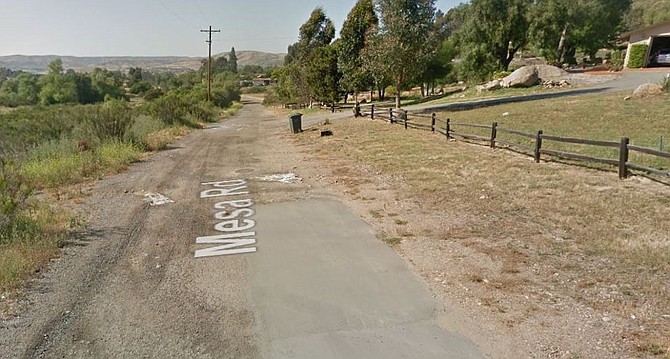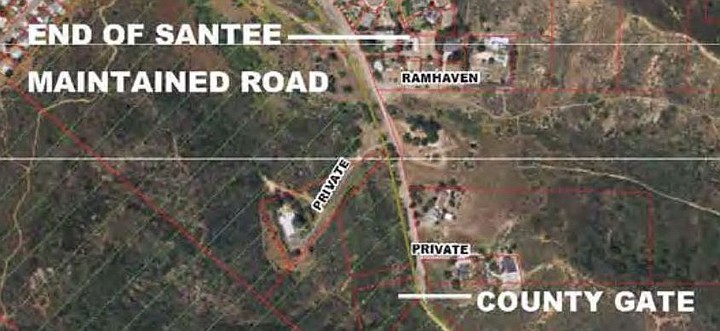 Facebook
Facebook
 X
X
 Instagram
Instagram
 TikTok
TikTok
 Youtube
Youtube

Just before Mesa Road spills into Mission Trails Regional Park in Santee, that last quarter mile is still a dirt path built before the auto, riddled with potholes.
In 1884 it was declared a public highway. Today, those who live in Santee say it's a city street while the city calls it a private road, and the county sees it as a park trail.
Last week, the 14 or so homeowners who live along the deeply rutted stretch learned that they won't be getting any help with paving from the city or county. They've been asking for 20 years.
The final answer from Santee is that the road leading to the trailhead is all theirs to maintain, even though most of its traffic is park-bound. Should a developer come along and improve it – then "it could be accepted into the city’s roadway system."

Where the same road turns smooth, it's part of the Mesa Heights subdivision where developer Lifetime Homes was required to build the road in 1990 to meet the city’s Public Works Standards next to their site.
The roadway south of the subdivision had no such requirement.
While the entire length of Mesa Road is within city limits, the city only maintains the section that comes before the rustic road.
According to local Allen Zwan, the city did provide temporary pavement one time, followed by some repairs a few years later.
"It has since fallen into a terrible state and it is only a matter of time before some resident or visitor to Mission Trails park is injured due to" its condition.
Neighbors have made their own repairs but in between patches, the dust still flies. In March, they raised the issue again at a city council meeting where the mayor advised they would get "a full report."
But at the next meeting, the road's history since 1884 was explained in a twisted tale of ownership that passed its maintenance back to the homeowners.
Neighbors say the 1884 county document proves it's a dedicated county road, and should therefore have automatically become a city road at the time of Santee's incorporation in 1980.
Yet, according to Santee officials, it was never accepted into the county road system, so the city isn't obligated to maintain it. At the time, the county was maintaining Mesa Road only from Mission Gorge Road to about the southern limits of the Mesa Heights subdivision.
"The county still claims fee ownership to that portion of Mesa Road south of the Mesa Heights subdivision," a staff report says. (The smooth portion was acquired by the developer from the county in 1990).
The record search found no evidence the road was ever dropped by the county, which has to follow a process when accepting or abandoning a road.
Santee officials suggest that Mesa Road wasn't accepted into the county road system because the "highway" has morphed into a trail.
The board's lack of action "is likely due to the creation of the Mission Trails Regional Park and the use of the road as a park trail."
Toby Brown, a resident who has sought help from the Mission Trails Regional Park Committee, estimates that eighty percent of the road's users are park visitors.
But "whoever owns the park, doesn't have the money or jurisdiction to do any road improvements adjacent" to it over here, he told the city. "They may help pay for it if the San Diego City Council got together with them."
"For families that live here, we really get the bad end of it because we're living on a dirt road" within the city limits.


Just before Mesa Road spills into Mission Trails Regional Park in Santee, that last quarter mile is still a dirt path built before the auto, riddled with potholes.
In 1884 it was declared a public highway. Today, those who live in Santee say it's a city street while the city calls it a private road, and the county sees it as a park trail.
Last week, the 14 or so homeowners who live along the deeply rutted stretch learned that they won't be getting any help with paving from the city or county. They've been asking for 20 years.
The final answer from Santee is that the road leading to the trailhead is all theirs to maintain, even though most of its traffic is park-bound. Should a developer come along and improve it – then "it could be accepted into the city’s roadway system."

Where the same road turns smooth, it's part of the Mesa Heights subdivision where developer Lifetime Homes was required to build the road in 1990 to meet the city’s Public Works Standards next to their site.
The roadway south of the subdivision had no such requirement.
While the entire length of Mesa Road is within city limits, the city only maintains the section that comes before the rustic road.
According to local Allen Zwan, the city did provide temporary pavement one time, followed by some repairs a few years later.
"It has since fallen into a terrible state and it is only a matter of time before some resident or visitor to Mission Trails park is injured due to" its condition.
Neighbors have made their own repairs but in between patches, the dust still flies. In March, they raised the issue again at a city council meeting where the mayor advised they would get "a full report."
But at the next meeting, the road's history since 1884 was explained in a twisted tale of ownership that passed its maintenance back to the homeowners.
Neighbors say the 1884 county document proves it's a dedicated county road, and should therefore have automatically become a city road at the time of Santee's incorporation in 1980.
Yet, according to Santee officials, it was never accepted into the county road system, so the city isn't obligated to maintain it. At the time, the county was maintaining Mesa Road only from Mission Gorge Road to about the southern limits of the Mesa Heights subdivision.
"The county still claims fee ownership to that portion of Mesa Road south of the Mesa Heights subdivision," a staff report says. (The smooth portion was acquired by the developer from the county in 1990).
The record search found no evidence the road was ever dropped by the county, which has to follow a process when accepting or abandoning a road.
Santee officials suggest that Mesa Road wasn't accepted into the county road system because the "highway" has morphed into a trail.
The board's lack of action "is likely due to the creation of the Mission Trails Regional Park and the use of the road as a park trail."
Toby Brown, a resident who has sought help from the Mission Trails Regional Park Committee, estimates that eighty percent of the road's users are park visitors.
But "whoever owns the park, doesn't have the money or jurisdiction to do any road improvements adjacent" to it over here, he told the city. "They may help pay for it if the San Diego City Council got together with them."
"For families that live here, we really get the bad end of it because we're living on a dirt road" within the city limits.
Comments